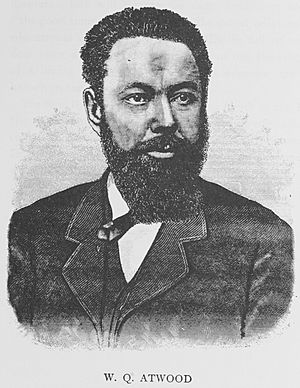William Q. Atwood facts for kids
Quick facts for kids
William Q. Atwood
|
|
|---|---|

Atwood in 1887
|
|
| Born | January 1, 1839 Wilcox County, Alabama, U.S.
|
| Died | December 21, 1910 (aged 71) Saginaw, Michigan, U.S.
|
| Occupation | Lumber baron |
| Political party | Republican |
William Q. Atwood (born January 1, 1839 – died December 21, 1910) was a very successful businessman. He became a "lumber baron" in Saginaw, Michigan. This means he owned large forests and sawmills, making a lot of money from selling wood.
William Atwood was born into slavery in Alabama. In 1853, he gained his freedom through his father's will. He then moved to Ohio, a free state. There, he helped people escape slavery as part of the Underground Railroad. During the American Civil War, Atwood moved to East Saginaw, Michigan in 1863. He became very successful in buying and selling land, and in the lumber business. He even opened his own sawmill in 1874. Atwood became one of the wealthiest African Americans in Michigan. He was also active in politics, especially with the Republican party. He was chosen to be a delegate at the 1888 Republican National Convention.
Contents
William Atwood's Early Life and Freedom
William Quincy Atwood was born on January 1, 1839. He was born into slavery on a plantation called Shell Creek. This was in Wilcox County, Alabama. His father, Henry Styles Atwood, was a white man and also his master. William's mother was enslaved and came from the Eastern Shore of Maryland. William had several brothers.
In 1853, Henry Atwood died. In his will, he set William and twenty-one other enslaved people free. This was a huge change for William and his family.
Moving North and Education
After gaining their freedom, William and the others traveled north. They settled in Ripley, Ohio. In Ripley, William went to a school for Black children. From 1856 to 1859, he studied at Iberia school. He later attended Berea College.
In 1859, William and his brother, John, went to California. William worked on steamboats and opened a restaurant. He even tried his hand at gold mining. John returned to Ohio first, and William followed in 1861. Ripley, Ohio, was located across the Ohio River from Maysville, Kentucky, which was a slave state. William Atwood might have helped people escape slavery through the Underground Railroad in that area.
Becoming a Lumber Baron in Saginaw
In the spring of 1862, Atwood visited East Saginaw, Michigan. He returned to Ripley later that year. The American Civil War (1861-1865) was happening. This made life challenging for young African-American men who were not soldiers. In the summer of 1863, he moved back to East Saginaw. There, he started buying and selling land.
Success in Real Estate and Lumber
In 1863, Atwood bought and sold 1,600 acres of land. He made a profit of $4,000 from this deal. This was the start of his success in real estate in Michigan. In the winter of 1868, Atwood began working with lumber. He made a profit of $6,000 the next year. He continued to cut millions of feet of lumber until 1877.
In 1874, he opened his own sawmill along the Saginaw River. He sold his lumber in many cities. These included Toledo, Cleveland, Chicago, and Boston. He was the only Black member of the Saginaw Board of Trade. This was a group of important business people. In 1893, a big fire in Saginaw destroyed two of Atwood's houses.
William Atwood's Community and Political Work
William Atwood was very active in his community and in politics. In 1866, he was the treasurer of the East Saginaw Colored Debating Society. This group helped people discuss important ideas. In 1871, he supported the new library of the Young Men's Christian Association.
Political Involvement
Atwood was a strong supporter of the Republican party his whole life. In 1884, he was chosen to attend the National Colored Convention in Richmond, Virginia. He was also nominated to be a delegate from Michigan to the 1884 Republican National Convention. However, only one Black man was chosen, and that honor went to Samuel C. Watson.
In 1888, Atwood became the first president of the Michigan Protective League. With the league's help, he campaigned for Benjamin Harrison, who became president. Atwood also served as a delegate at the 1888 Republican National Convention in Chicago. In 1890 and 1895, he was a delegate at other national conventions for Black men.
Family Life and Legacy
William Atwood married Charlotte Echols on May 15, 1872. They were married in Cleveland, Ohio. Charlotte was a schoolteacher. They had five children: Willie, Freddie Stiles, Oliver Kossuth, Alice May, and Lottie. Sadly, Charlotte passed away in 1895.
William Atwood died on December 21, 1910, in Saginaw. He was buried in Forest Lawn Cemetery in Saginaw. In 2002, William Atwood was honored by being inducted into the Saginaw Hall of Fame. This shows how important he was to his community.

